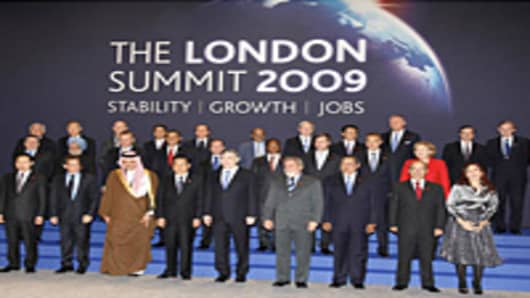The word in London was to not look like a banker but to wear blue jeans so as to be able to get to and from work without incident during the G20 meeting. Probably good advice, but of no help to our President, who had to dress up and face the hostile world as leader, not candidate, for the first time.
Sarkozy of France threatened to walk out unless he got his way. Merkel doesn't want to hear about further stimulus, Russia wants it all, and China wants more status. All of them want to pay back the US for causing all the ills of the world, and if the personally popular Obama happens to be in the way, well that's too bad. Joe Biden said the new President would be tested right away and here it is.
It's usually a relief for a head of state to get away for a while, but the news is picking up enough here that getting back might be a pleasure. The ISM (Institute of Supply Management) survey still showed contraction, but was better than expected for the third month in a row. Auto sales were bad, but better than feared, and I wonder if the first round of the TALF helped. In the initial allocation was money for securitized auto loans, and, while I would have thought it would have taken longer to work through the system, maybe not. Contracts for new home sales were also up a bit.
The Financial Times reported the US National Association of Realtors home affordability index is at its most favorable reading since 1971. That doesn't mean people will necessarily buy houses, but, with the Fed determined to lower mortgage rates, it could mean the end of the nightmare is shaping up.
The new rules on mark-to-market accounting will be issued soon, and that might account for some short-covering in the bank stocks, which have led the way in every up-day on the market. There is fear that the P-PIP (Public- Private Investment Partnership) will not get off the ground. But read along the following line of reasoning as to how it could. And I am indebted to David Kotak at Cumberland Associates for much of this.
Loans are held at full value until they don't pay. Then reserves are set against the likelihood of a bad ending. I'm told that all sorts of loans are valued around $0.90 on the dollar but there is no real trading activity. Banks will be reluctant to sell much below face value since such a sale would trigger a big write-off. But let's say we put up $6.25 and the government matches it. We then have $12.50 and the rules say we can borrow (non recourse) 6 times that, or $75. We have a total of $87.50 we could bid for a $100 face amount loan. If that entices a seller, our profit potential is the $100 face amount at maturity. If we get $100, we pay back the $75 we borrowed and split $25 with the government for a 100% gain on our $6.25 investment. This is too perfect, but it's where negotiations could start. The government will be stress-testing the big banks, and part of it could well be figuring at what price the bank could sell off loans and still have viable capital. Gee, could the game be rigged?
The market surprised us all on Wednesday, the first day of a new quarter. A sharp slide at the opening triggered by a very negative job loss estimate by ADP was met by renewed buying when the more favorable ISM numbers were released. The S&P was led by financials, but those stocks were joined by technology, industrials, and energy issues. Volume could have been heavier, but we closed well above the 50-day moving average (811 versus 790) and even finished a bit above that 20% discounted mark to the 200-day moving average that acted as a lid for so long (the 200-day is at 1009, so a 20% discount would be 807, and we are at 811).
A nice way to start the new quarter.
_______________________________________


